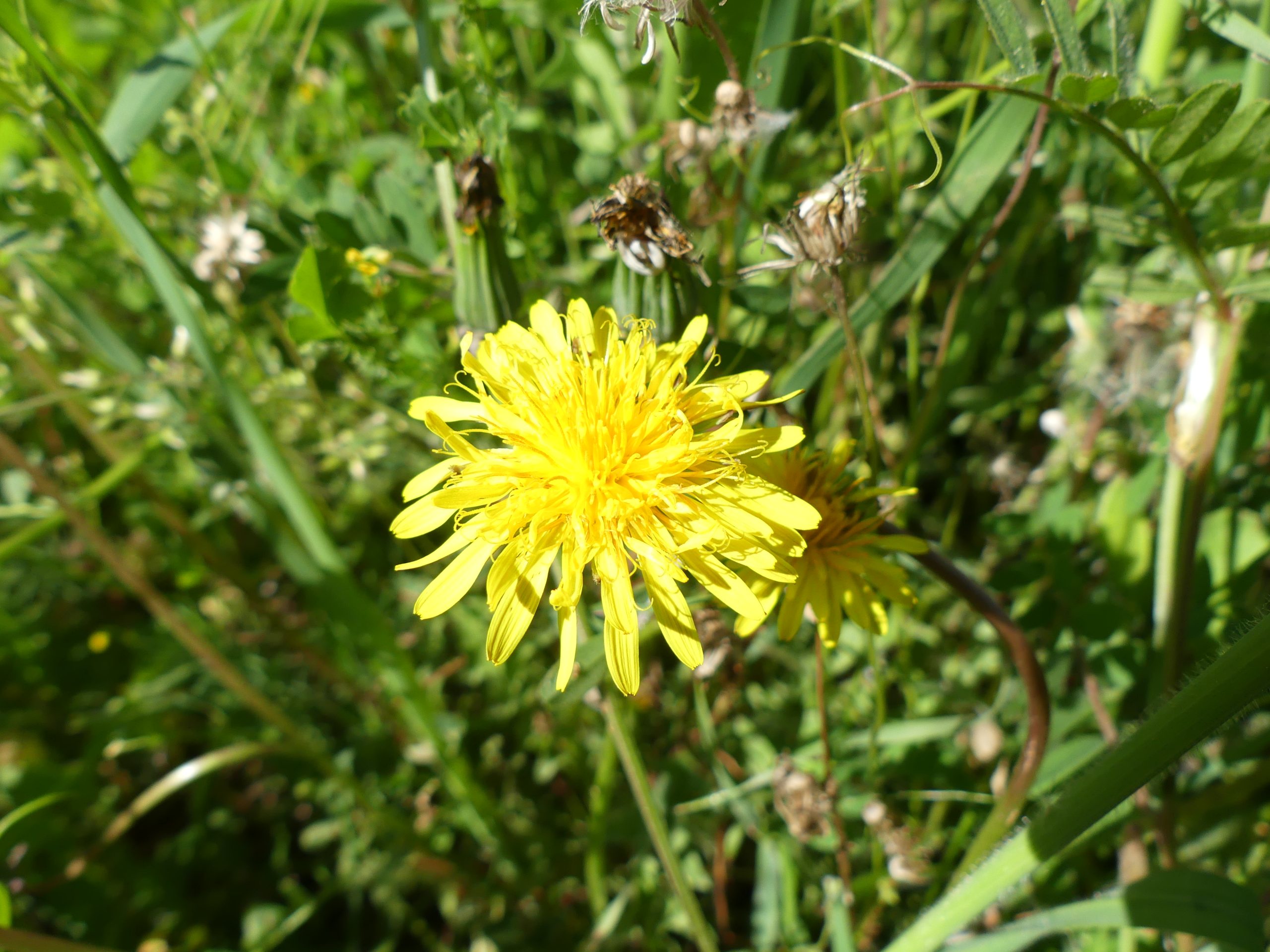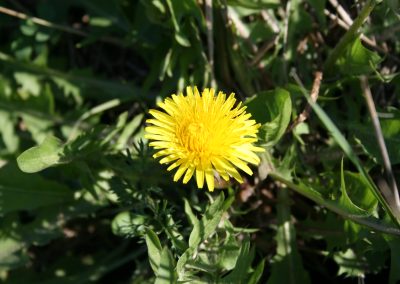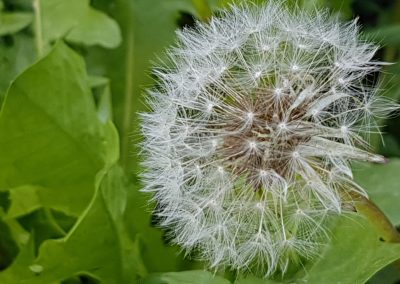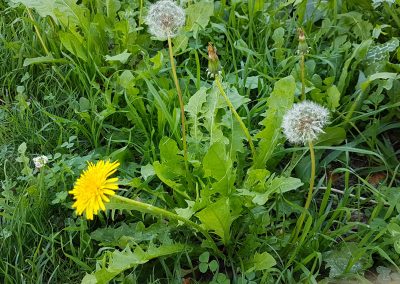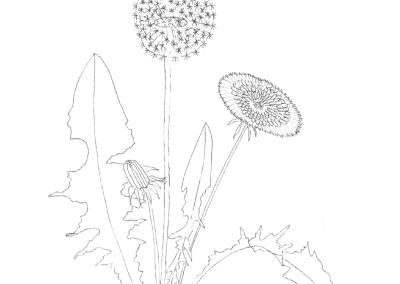Taraxacum sp
Scientific description
Taxon: Taraxacum officinale
Class: Magnoliopsida
Subclass: Asteridae
Order: Asterales
Family: Asteraceae
Common name: Dandelion
Origin:
Native to Eurasia, now cosmopolitan.
Description:
Perennial herbaceous plant forming a basal rosette of deeply toothed, broad and elongated green leaves with irregular edges. Hollow, leafless stem bears a single bright yellow flower composed of many ligulate florets. Flowering occurs from spring to autumn. After flowering, produces a spherical head of fluffy achenes dispersed by wind. Hardy, easily colonizes meadows, lawns, roadsides, and disturbed areas.
Propagation:
By very light seeds dispersed by wind (anemochory). Vegetative multiplication by root fragments.
Ecology:
Pioneer plant of open and disturbed habitats, tolerant of wide range of soils and climates. Supports biodiversity by providing nectar and pollen for insects.
Use:
Consumed in salads (young leaves), used in herbal medicine for diuretic, digestive, and detoxifying properties. Limited ornamental use.
Threat:
Not threatened. Very common species, sometimes considered invasive.
Taxon: Taraxacum officinale
Classe: Magnoliopsida
Sous-classe: Asteridae
Ordre: Asterales
Famille: Astéracées
Nom commun: Pissenlit / Dent-de-lion
Origine:
Originaire d’Eurasie, aujourd’hui cosmopolite.
Description:
Plante herbacée vivace formant une rosette basale de feuilles profondément dentées, larges et allongées, vertes à bords irréguliers. Tige creuse, sans feuilles, portant une seule fleur jaune vif composée de nombreux petits fleurons ligulés. Floraison : printemps–automne. Après floraison : capitule sphérique d’akènes plumeux dispersés par le vent. Très rustique, colonise facilement prairies, pelouses, bords de routes et terrains perturbés.
Multiplication:
Par graines très légères, dispersées par le vent (anémochorie). Multiplication végétative par éclats de racines.
Écologie:
Plante pionnière des milieux ouverts et perturbés, tolérant une large gamme de sols et climats. Favorise la biodiversité en offrant nectar et pollen aux insectes.
Utilisation:
Consommée en salade (feuilles jeunes), utilisée en phytothérapie pour vertus diurétiques, digestives et détoxifiantes. Usage ornemental limité.
Menace:
Non menacée. Espèce très commune, parfois considérée comme envahissante.
Taxon: Taraxacum officinale
Clasă: Magnoliopsida
Subclasă: Asteridae
Ordin: Asterales
Familie: Asteraceae
Denumire populară: Păpădie
Origine:
Originar din Eurasia, acum cosmopolit.
Descriere:
Plantă erbacee perenă formând o rozetă bazală de frunze adânc dințate, late și alungite, verzi cu margini neregulate. Tulpina goală, fără frunze, poartă o singură floare galbenă strălucitoare, formată din numeroase flori ligulate. Înflorește primăvară–toamnă. După înflorire produce cap sferic de achene pufoase, dispersate de vânt. Foarte rezistentă, colonizează pajiști, peluze, margini de drumuri și terenuri perturbate.
Propagare:
Prin semințe foarte ușoare dispersate de vânt (anemohorie). Multiplicare vegetativă prin fragmente de rădăcină.
Ecologie:
Plantă pionieră a habitatelor deschise și perturbate, tolerantă la o gamă largă de soluri și climaturi. Susține biodiversitatea prin nectar și polen pentru insecte.
Utilizare:
Consumată în salate (frunze tinere), folosită în fitoterapie pentru proprietăți diuretice, digestive și detoxifiante. Utilizare ornamentală limitată.
Amenințare:
Nu este amenințtată. Specie foarte comună, uneori considerată invazivă.
Ταξινόμηση: Taraxacum officinale
Κλάση: Magnoliopsida
Υποκλάση: Asteridae
Τάξη: Asterales
Οικογένεια: Asteraceae
Κοινή ονομασία: Πικραλίδα
Προέλευση:
Καταγωγή από την Ευρασία, σήμερα κοσμοπολίτικο είδος.
Περιγραφή:
Πολυετές ποώδες φυτό σχηματίζοντας βασική ροζέτα από βαθιά οδοντωτά, πλατιά και επιμήκη φύλλα με ακανόνιστα άκρα. Κούφιος, χωρίς φύλλα βλαστός φέρει ένα μόνο φωτεινό κίτρινο άνθος από πολλά μικρά γλωσσωτά άνθη. Άνθηση: άνοιξη–φθινόπωρο. Μετά την άνθηση παράγει σφαιρική κεφαλή από πτητικούς καρπούς (αχένια), διασκορπιζόμενους από τον άνεμο. Πολύ ανθεκτικό, αποικίζει λιβάδια, γκαζόν, δρόμους και διαταραγμένες περιοχές.
Διάδοση:
Με πολύ ελαφρούς σπόρους που διασκορπίζονται από τον άνεμο (ανεμοχορία). Αναπαραγωγή και με κατακερματισμό ριζών.
Οικολογία:
Φυτό πρωτοπόρο σε ανοικτά και διαταραγμένα οικοσυστήματα, ανθεκτικό σε ποικιλία εδαφών και κλιμάτων. Προωθεί τη βιοποικιλότητα προσφέροντας νέκταρ και γύρη σε έντομα.
Χρήση:
Καταναλώνεται σε σαλάτες (νεαρά φύλλα), χρησιμοποιείται στη φυτοθεραπεία για διουρητικές, πεπτικές και αποτοξινωτικές ιδιότητες. Περιορισμένη διακοσμητική χρήση.
Απειλές:
Δεν απειλείται. Πολύ κοινό είδος, μερικές φορές θεωρείται εισβολικό.
Creative writing inspired by Taraxacum sp
The child and the magic dandelion
Once upon a time, a little child lived in a small house in the country with his mother and father, who was seriously ill. The father was unable to speak or move. All day long he lay on the sofa in front of the window, which overlooked a magnificent field of dandelions.
The little boy was curious, mischievous, with sparkling eyes and a bright smile, and dreamed of enchanted adventures in a magical, fairy-tale world, but his only wish was that his father would get well and be able to get up and run with him in that beautiful dandelion field.
On a day like any other since his dad had been ill, as soon as he woke up, he didn't waste a single second and ran out into the middle of the dandelions, which were everywhere, to the right, to the left, in front and behind. He didn't think the gray ones were pretty and made a mess of the dandelion field, so he used to pull them out and throw them away. In the distance, he saw a woman looking at him, but did nothing about it.
Until the day he went out, the little boy was very sad because his father was at the end of his life. He didn't have much time left before he died. The child sat down in the middle of all those yellow flowers, kept pulling out the grey ones and crying for his poor daddy, asking and begging that his father would pull through, that he would live longer, that he would no longer suffer from this horrible disease. And he finished by blowing on the gray flower, which evaporated into the sky.
It was getting late, and the young boy decided to dry his tears and go home. On his way home, he heard crying – his poor mother crying. He entered the bedroom and saw his father standing there, accompanied by his mother. A shock to the child, he hadn't expected it at all, so he jumped up and cried with joy – he was so happy to see his dad back on his feet. His wish had come true. For him, it was the happiest day of his life.
As night fell, the child was as happy as ever, and asked himself a thousand and one questions. He pondered and remembered the woman watching him from afar, wondering if she was a fairy, and if she was the one who would grant his wish. The child hurried out in search of the woman, figuring he'd probably run into her. And he was right: she was sitting in the middle of the dandelions, contemplating this magnificent field.
The young boy sitting next to her didn't have time to ask all the questions that crossed his mind, as the woman began to explain. She told him that when you make a sincere wish, it will come true the second you blow on the dandelion. The boy couldn't understand how this could be, so he looked at the field and when he turned to the woman, she disappeared.
Disappointed that he hadn't had time to ask his questions, the young boy returned home smiling as he realized that the flowers he'd been throwing away for so many years, thinking they were bland, were simply the cure for his father's illness. The young boy finally lived his life with his parents, filled with happiness and immense joy.


